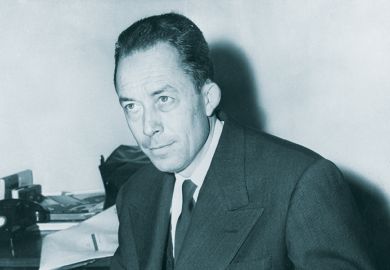This volume weighs in as number 26 of the Cambridge Studies in 19th-Century Literature and Culture. Under its general editor Gillian Beer,this well-established series has specialised in sharply angled monographs - several (like this) reflecting Beer's (and the publisher's) fascination with the interdisciplinary territory between literary study and the history of science.
Ronald Thomas's contribution trespasses somewhat by devoting a third of its length to works that can, by no stretch, be located in the "19th century" - The Big Sleep, The Long Goodbye, The Maltese Falcon, Murder on the Orient Express . The book is none the worse for its elasticity of definition.
Despite the title's use of the term "rise", Thomas offers no comprehensive account of the genesis or narrative of the generic evolution of detective fiction. He has no time for unambitious taxonomy or anatomy. Julian Symons's Bloody Murder, a work which crawls over the genre as methodically as a caterpillar over a cabbage leaf, does not get a mention in Thomas's otherwise comprehensive bibliography. Symons's pedestrian commentary is beneath modern critical notice.
Thomas's monograph depends on three concurrent lines of discussion, themselves dependent on the base proposition that "the history of detective fiction is deeply implicated with the history of forensic technology" and reflects the "systematic medicalisation of crime" and its literary representations.
The first such technological innovation is Cesare Lombroso's original 1895 lie-detector, or "plethysmograph", itself a descendant of the binaural stethoscope and the "sphymograph" (happily, the text is generous with illustrations of each polysyllabic apparatuses). Both lie-detector and detective examine "physical evidence", with the assumption that crime, as in Kafka's penal colony, is indelibly - if allegorically - inscribed on or in the body of the criminal.
By a simple critical leap, the criminal body - as textualised by the agencies of law and the sensibility of the novelist - becomes a "kind of automatic writing machine" whose involuntary script, or corporeal semiology, is decoded by "thinking machines", like Holmes, Dupin, or Sergeant Cuff. Or Scotland Yard.
Thomas explains all this neatly and effectively. Genetically, he sees Poe as the procreator and (rather than Dickens) the dominant influence on Wilkie Collins. The link is backed up by a long chapter on The Woman in White in which much is made of the "mark of the Brotherhood" on Fosco's fat body, visible as his corpse lies naked in the Paris Morgue. Now I think of it, Hart-right must have seen the same mark on Pesca's body, when he rescued him from drowning; does Collins allude to it?
Sherlock Holmes, unsurprisingly, is applauded as "the most efficient incarnation of a lie-detecting device in literature". Conan Doyle's sleuth is also central in Thomas's discussion of the second of the forensic technologies which fructify with the early crime fiction, "the mug shot and the magnifying glass".
Use of the bureaucratically filed and processed photograph, for detective purposes, reached its fully formed modern condition with Inspector Thomas Byrnes's 1880s New York "Rogues Gallery", and Alphonse Bertillon's Parisian version of the mug shot, the portrait parl é. Thomas gives the technological history and astutely notes how Holmes with his hallmark magnifying glass "is a camera", just like Herr Issyvoo 50 years later.
Thomas offers a chapter-long exposition of Bleak House , interpreted through the topos of photography - anachronistic in terms of the novel's early setting but very much in line with Dickens's interests in the 1850s (he sat for at least two photographic portraits during the composition of the novel).
The analyses of "double exposure" as a motif in The House of the Seven Gables and of the "empty cameras" in The Big Sleep are, I think, a couple of chapters too far along this line.
Thomas's third forensic device is the fingerprint, as introduced into A Study in Scarlet and The Sign of Four (via the "prints of a naked foot" which Holmes decrypts as not those of a child). Thomas wraps up the section with Mark Twain's conscious introduction of Francis Galton's pioneering book Finger Prints into Pudd'nhead Wilson . Thomas ends with a perfunctory section on "Missing Persons", linked to The Secret Agent . CUP does not like fat volumes, and the author may at this stage have been obliged to draw in his horns.
Detective Fiction and the Rise of Forensic Science fits in well with a series that now has its own distinctive character and utility. It is a slight irritation that Thomas hews so faithfully to the Foucault, D. A. Miller, Franco Moretti line that Victorian society was tyrannised to a more-than-Orwellian degree by state agencies of surveillance, internalised regulation and policing, the more sinister because "invisible".
This objectionable parti pris lies lightly on an otherwise eminently sensible and informative book.
John Sutherland is professor of modern English literature, University College London.
Detective Fiction and the Rise of Forensic Science
Author - Ronald R. Thomas
ISBN - 0 521 65303 7
Publisher - Cambridge University Press
Price - £37.50
Pages - 341
Register to continue
Why register?
- Registration is free and only takes a moment
- Once registered, you can read 3 articles a month
- Sign up for our newsletter
Subscribe
Or subscribe for unlimited access to:
- Unlimited access to news, views, insights & reviews
- Digital editions
- Digital access to THE’s university and college rankings analysis
Already registered or a current subscriber? Login



